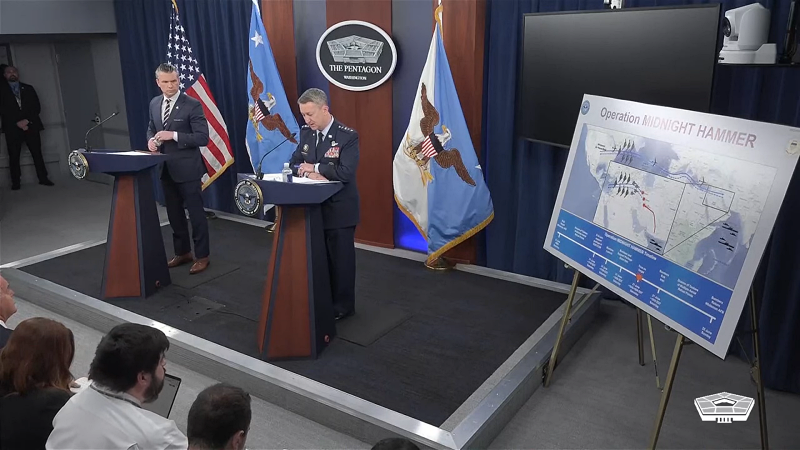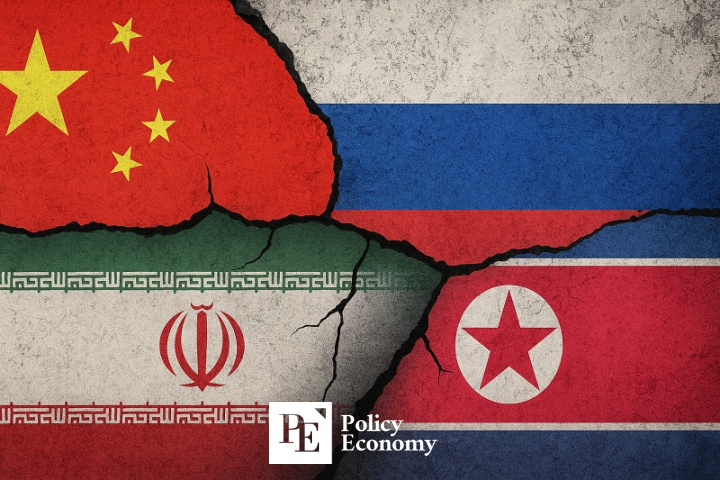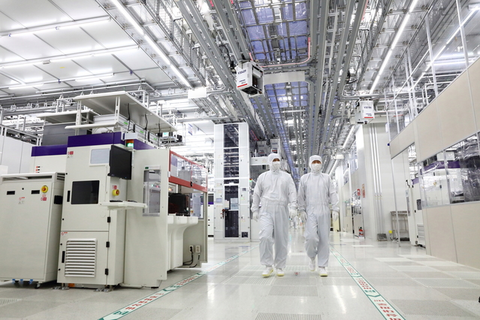U.S. Airstrike Thwarts Iran's Nuclear Development, Shaking Middle East Order and the 'Axis of Evil'
Input
Modified
Preemptive Strike Approach Contrasts with Diplomatic Engagement Possibility of Intensified Regional Power Struggle in the Middle East Signs of CRINK Framework Collapse Amid Iran Crisis

The United States has carried out precision airstrikes using massive bombs and missiles on three underground nuclear facilities in Iran, opting for military force over diplomacy to curb nuclear development. This strike has significantly undermined Iran's standing in the Middle East, prompting neighboring countries to simultaneously readjust their diplomatic strategies, including distancing themselves from Iran. At the same time, concerns are emerging that a key pillar of the anti-American bloc, including Russia, China, and North Korea, may collapse. As a result, the international community is viewing this incident as a potential signal of a global order reshuffle.
U.S. Airstrike Pierces Bunkers, Disables Key Nuclear Facilities
On the 22nd (local time), Reuters and other foreign media reported that President Donald Trump announced on his social media platform that the United States had “successfully completed bombing of nuclear facilities in Iran,” stating, “We dropped the full payload on Fordow, a key target in Iran.” He added, “Congratulations to our great American warriors.”
The strike sites disclosed by President Trump include Fordow, Natanz, and Isfahan, three critical sites at the core of Iran’s nuclear program.
Most of these Iranian nuclear facilities are located dozens of meters underground within reinforced concrete bunkers. In response, the U.S. reportedly deployed at least six of its massive GBU-57 bunker-buster bombs, known as the only weapon capable of destroying deeply buried nuclear facilities without ground operations. In addition, the U.S. launched over 30 Tomahawk missiles, demonstrating both destructive force and precision deterrence in a single coordinated operation.
There is also evidence of pre-coordination with Israel during the airstrike. According to White House officials, President Trump had a phone call with Israeli Prime Minister Benjamin Netanyahu immediately following the attack. Analysts suggest they likely discussed the rationale, operational specifics, and anticipated developments. Israel has long viewed Iran’s nuclear development as a direct security threat and has cooperated closely with the U.S. on monitoring efforts.
This U.S. strike marks a turning point, a shift from diplomatic engagement to military action, acknowledging the limitations of diplomacy in dealing with nuclear-aspiring states. For years, the international community employed negotiation, sanctions, and inspections to contain Iran’s nuclear ambitions, but with little meaningful success. Instead, Iran took advantage of this window to reinforce underground facilities and increase its stockpile of highly enriched uranium, covertly inching closer to nuclear armament. From a diplomatic standpoint, the strike signals that existing measures were deemed insufficient to prevent nuclear proliferation.
Middle East Recalibrates Amid Power Vacuum
With Iran’s nuclear development abruptly halted, the political and military dynamics of the Middle East are being thrown into flux. Until now, Iran has been both the standard-bearer of Shia Islam and a cornerstone of the anti-American axis in the region. However, the crippling of its nuclear infrastructure, the backbone of its regional influence — has led to a rapid decline in its standing. The prevailing sentiment is that, without an immediate military response or retaliation from Iran, neighboring countries no longer perceive it as a fearsome power.
Among those closely watched in this new landscape is Saudi Arabia. Should Iran's influence wane, Saudi Arabia is expected to fill the resulting vacuum within the Shia bloc, and in doing so, expand not only its military role but also its political and economic clout. Saudi Arabia has recently shown a far more flexible posture, even publicly supporting renewed U.S.-Iran nuclear talks — a notable shift from the past.
This stance is seen as a strategic move to reduce national security uncertainty by de-escalating tensions with its geopolitical rival. At the same time, Saudi Arabia is carefully monitoring the scale and scope of U.S. involvement in the region, aiming to enhance its own strategic autonomy. Analysts are characterizing this as a form of “dual-track pragmatic diplomacy”, noting that Saudi Arabia seems to be positioning itself as either a new mediator or central player amid shifting geopolitical fault lines.
Beyond Saudi Arabia, several Gulf states with traditionally close ties to Iran are now distancing themselves. Countries such as the United Arab Emirates (UAE), Qatar, and Oman, once economically or religiously aligned with Iran, are now reevaluating their cooperative stances in the wake of the U.S.–Iran confrontation.
This strategic realignment is giving rise to speculation about the formation of a new “pro-U.S. belt” in the Middle East. Ultimately, Iran’s potential collapse is not simply the transfer of power from one actor to another but rather a redistribution of power among multiple stakeholders, including the U.S., vying for renewed influence in the region.

Preemptive Strikes on Nuclear-Armed Nations Now Seen as Plausible
The international community is closely watching the Iran crisis, with growing concern that it could fracture the emerging new Cold War framework known as "CRINK," an informal bloc comprising China, Russia, Iran, and North Korea, aligned in opposition to the West. These countries have recently deepened cooperation across a range of areas, including security, energy, and military technology. Within this bloc, Iran has served as both a geostrategic linchpin and a symbolic anti-U.S. force, widely seen as a pillar in what has been called the “Axis of Evil.” However, the prevailing view is that Iran’s strategic value may diminish following the recent U.S. strike, potentially weakening the cohesion of the entire bloc.
Until now, the U.S. has relied mainly on negotiation, sanctions, and international surveillance to address these states. But with Iran becoming a target of direct military action, the pressure is now on other CRINK members to reassess their national security strategies.
China, for example, is heavily dependent on Middle Eastern energy, and prolonged instability in Iran could threaten China’s own economic stability. Russia, meanwhile, is already stretched thin by the protracted war in Ukraine, limiting its capacity to respond to simultaneous global security crises.
More significantly, the prospect of direct military action against other CRINK nations is beginning to look more plausible. Both North Korea and Russia, deeply engaged in nuclear development and full-scale warfare, respectively, are likely to interpret the Iran strike as a precision warning shot. Given that the U.S. appears to have moved beyond its long-standing doctrine of using military force only as a last resort, further military interventions may be perceived as not only possible but also strategically viable.
Observers also predict that without Iran, the CRINK bloc may lose its strategic depth and versatility. Iran had played a critical role in maintaining geopolitical balance within the group; without it, North Korea, China, and Russia may be forced to shoulder heavier diplomatic and military burdens.
This shift paves the way for the U.S. to implement a “divide and isolate” strategy more effectively, applying pressure to each nation individually rather than confronting a united front. This is why Iran’s downfall is being interpreted not simply as a power transition within the Middle East, but potentially as a spark that could ignite a broader restructuring of the global order. The erosion of CRINK’s strategic unity would give the U.S. and its allies new leverage, transforming what began as a regional strike into a global inflection point in the balance of power.





















